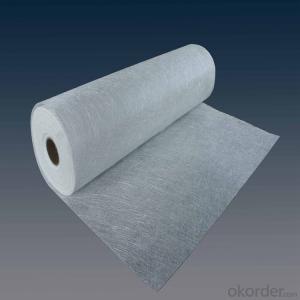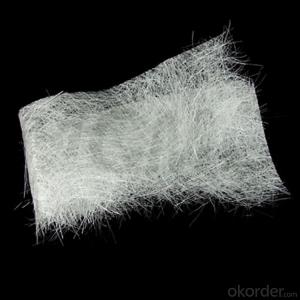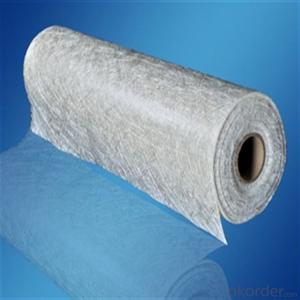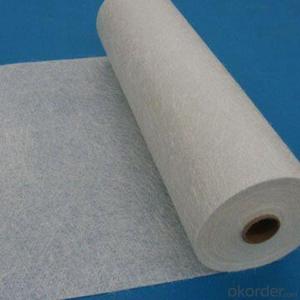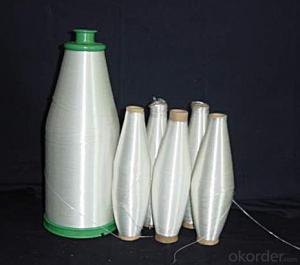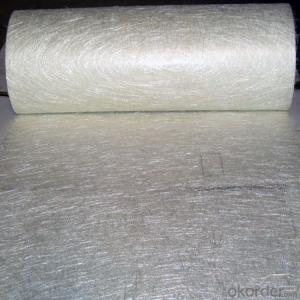CSM Glass Fiber Chopped Strand Mat/Fiberglass Mat/Emulsion or Powder Mat
- Loading Port:
- China main port
- Payment Terms:
- TT OR LC
- Min Order Qty:
- 50 kg
- Supply Capability:
- 10000 kg/month
OKorder Service Pledge
OKorder Financial Service
You Might Also Like
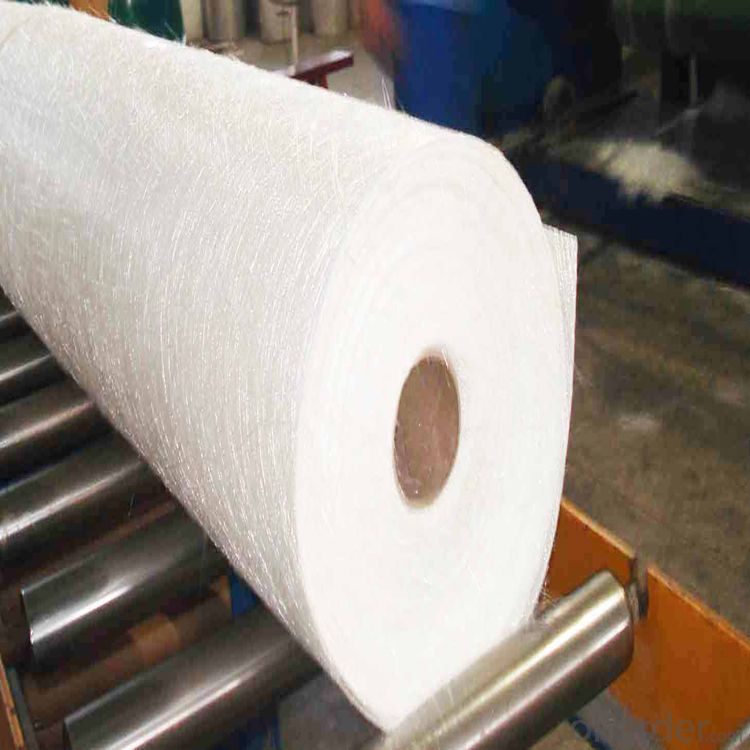
Product Description:
Fiberglass Chopped Strand Mat is fine strand reinforcement material made from E-glass cut fibers laid in a random pattern and bonded with powder or emulsion binder.
It is easy to handle and has excellent moulding performance.
Also, it has rapid resin penetration together with a fast strand wet out time.
The mat also brings a highly translucent finished laminates.
Also,the fine strand input makes the fiber prominence at the finished laminates surface extremely low.
Features
1.Excellent weight uniformity
2.Fast wet out
3.Easy air release
4.Excellent transparency of finished products
5.Excellent laminate
6.Low resin consumption
Application
1.Translucent roof panel
2.chemical storage tanks
3.FRP pipes
4.Boat hulls
5.Decks
6.Truck body panel
7.Cooling towers
8.Corrosion resistand
Specifications:
Item | Over Density | Moisture Content | Chop Density | Polyester Yarn | Width |
(g/m2) | (%) | (g/m2) | (g/m2) | (mm) | |
EMK300 | 309.5 | ≤0.15 | 300 | 9.5 | 50-3300 |
EMK380 | 399 | 380 | 19 | ||
EMK450 | 459.5 | 450 | 9.5 | ||
EMK450 | 469 | 450 | 19 | ||
EMC0020 | 620.9 | 601.9 | 19 | ||
EMC0030 | 909.5 | 900 | 9.5 |
Special products are available according to customer’s requirement.
Product Packaging:
Each Surface Tissue is wound onto a paper tube which has an inside diameter of 76mm and the mat roll has a diameter of 330mm. The mat roll is wrapped up with plastic film,and then packed in a cardboard box or wrapped up with kraft paper. The rolls can be vertically or horizontally placed. For transportation, the rolls can be loaded into a cantainer directly or on pallets.
Quantity
20'GP Container:About 10000kgs
40'HP Container:Aboout 23100kgs
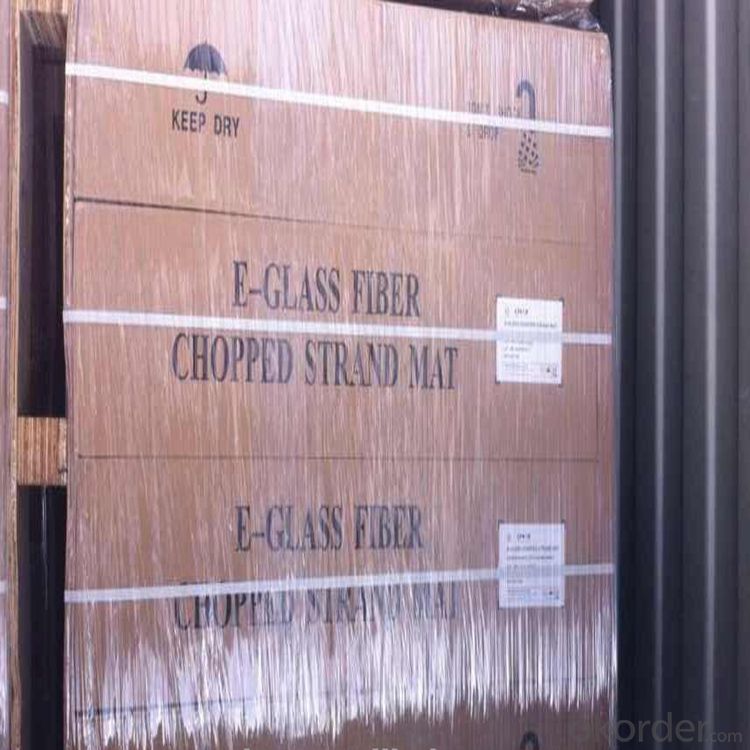
Product Storage:
Unless otherwise specified, Chopped Strand Mat should be stored in a dry, cool and rain-proof area. It is recommended that the room temperature and humidity should be always maintained at 15℃~35℃ and 50%~75% respectively.
Company Information
CNBM (China National Building Material) Group is the largest comprehensive building materials group in China that in integrate scientific research, manufacturing and logistics into one entity. The largest building materials and equipment specialists in China. Upon State Council approval, today CNBM owned more than 300 subordinate manufacturing factories and servicing companies. There are 6 fully owned public listed companies and 11 partially owned with substantial shares public listed companies. In many of these fields, CNBM is playing the leading role in the building industry in the country.

Our Service:
1.Any inquiry will be replied within 24 hours.
2.Professional manufacturer.
1) Print logo in the products;
2) The size and specification can be produce and design according to your demand.
3.High quality,fashion designs,reasonable and competitive price,fast lead time.
4.After-sale service
1) All products will have been strictly quality check in house before packing.
2) All products will be well packed before shipping.
3) All our products have 10 years rot resistance.
5.Faster delivery:sample order in stock,and 15-20 days for bulk production.
6.Payment:you can pay for the order via:T/T,Western Union,MoneyGram,L/C etc.
FAQ:
which kind of glass fiber sample and materials can you provide?
We can provide the glass fiber and glass fiber down stream products samples of E glass, C glass, ECR glass, High alkali glass. The products includes single end roving, assembled roving for different applications( Piping, SMC, panel, winding mill plate) , chop strand for BMC, engineering plastic (PA, PPA, PPT, POM, etc), chop strand mat (from 100gsm-900gsm) for automobile and water tank, etc, woven roving (270gsm-800gsm), surface tissue (25-50gsm), multi-axial fabric of different unit weight.
- Q:Is fiberglass chopped strand suitable for electrical insulation in high-voltage applications?
- No, fiberglass chopped strand is not suitable for electrical insulation in high-voltage applications. While fiberglass is a widely used material for insulation in various applications, it may not possess the necessary dielectric properties to effectively withstand high voltages. High-voltage applications typically require specialized insulation materials with superior dielectric strength and resistance to electrical breakdown. These materials are specifically designed to prevent the flow of current and the occurrence of electrical discharge, ensuring the safety and functionality of the electrical system. Therefore, it is recommended to use insulation materials specifically designed and tested for high-voltage applications, rather than relying on fiberglass chopped strand for electrical insulation in such scenarios.
- Q:How does the flexibility of fiberglass chopped strand affect its handling and processing?
- The flexibility of fiberglass chopped strand makes it easier to handle and process. It can be easily molded into various shapes and sizes, making it suitable for a wide range of applications. Its flexibility also allows for easy mixing and dispersion in various resins, enabling efficient and uniform reinforcement throughout the composite material.
- Q:What are the UV stability properties of fiberglass chopped strand?
- Fiberglass chopped strand has excellent UV stability properties. UV stability refers to the ability of a material to withstand the damaging effects of ultraviolet (UV) radiation from the sun. Fiberglass, being a composite material made from fine fibers of glass, is highly resistant to UV radiation. The main reason for the good UV stability of fiberglass chopped strand is the composition of the material. Fiberglass is made from glass fibers that are reinforced with a polymer matrix, which provides additional stability and protection against UV radiation. The glass fibers themselves are inherently resistant to UV damage, as glass is not affected by UV radiation in the same way that organic materials are. Furthermore, the polymer matrix used in fiberglass chopped strand is often a thermosetting resin, such as polyester or epoxy. These resins are designed to have excellent UV resistance, ensuring that the material remains stable and does not degrade or deteriorate when exposed to sunlight. In addition to the composition of the material, the manufacturing process also contributes to the UV stability of fiberglass chopped strand. During the manufacturing process, the glass fibers are typically coated with a sizing agent, which further enhances the UV resistance of the material. The sizing agent forms a protective barrier around the glass fibers, shielding them from the harmful effects of UV radiation. Overall, fiberglass chopped strand exhibits excellent UV stability properties, making it a popular choice for various applications that require durability and resistance to outdoor environments. This includes applications such as automotive parts, marine equipment, construction materials, and other products that are exposed to sunlight and UV radiation.
- Q:How does the fiber diameter affect the surface finish of fiberglass chopped strand composites?
- The surface finish of fiberglass chopped strand composites is greatly influenced by the diameter of the fibers. A finer diameter generally yields a smoother finish, while a larger diameter typically results in a rougher finish. When fiberglass chopped strand composites are used for various applications, the fibers are dispersed randomly within the resin matrix. The diameter of the fibers impacts how they align and distribute themselves within the composite material. Finer diameter fibers have a tendency to align parallel to the surface, resulting in a smoother finish. On the other hand, larger diameter fibers are more likely to be distributed randomly, leading to a rougher surface finish. Moreover, the fiber diameter also affects the overall ratio of fibers to resin in the composite. Finer diameter fibers can be packed more densely in the matrix, increasing the fiber content. This higher fiber content enhances the mechanical properties of the composite and promotes a smoother surface finish by improving the bond between the fibers and the resin. Additionally, the fiber diameter influences the flow of resin and how it wets the fibers during the manufacturing process. Finer diameter fibers allow for better impregnation and wetting of the resin, resulting in a more uniform distribution and a smoother surface finish. Conversely, larger diameter fibers may impede resin flow and wetting, leading to voids, areas with excessive resin, or areas lacking resin, and ultimately a rougher surface finish. To summarize, the diameter of the fibers has a significant impact on the surface finish of fiberglass chopped strand composites. Finer diameter fibers promote better alignment, increased fiber content, improved resin impregnation, and wetting, resulting in a smoother finish. Conversely, larger diameter fibers tend to yield a rougher finish due to random fiber distribution, hindered resin flow, and wetting.
- Q:Does fiberglass chopped strand improve the fire resistance of composite materials?
- Yes, fiberglass chopped strand can improve the fire resistance of composite materials. Fiberglass is known for its high melting point and low thermal conductivity, making it a suitable reinforcement material for enhancing fire resistance properties in composites. When added to a composite material, fiberglass chopped strand can act as a barrier, preventing the spread of flames and reducing the rate of heat transfer. Additionally, the use of fiberglass chopped strand can enhance the structural integrity of the composite during fire exposure, as it has a high strength-to-weight ratio. However, it is important to note that the fire resistance properties of a composite material also depend on other factors such as the resin matrix used, the manufacturing process, and the overall composition of the composite.
- Q:What are the typical quality control measures for fiberglass chopped strand composites?
- To ensure the integrity and consistency of fiberglass chopped strand composites, various typical quality control measures are commonly employed: 1. Raw Material Inspection: The initial step involves inspecting the raw materials used in production. This includes assessing the quality and specifications of the glass fibers, resins, and additives to ensure they meet the required standards. 2. Process Control: Throughout the manufacturing process, quality control measures monitor and control parameters like temperature, pressure, and resin-to-fiber ratio. This ensures consistency and conformity to specifications. 3. Fiber Length and Distribution: The mechanical properties of the composite are influenced by the length and distribution of the chopped fibers. Quality control measures are used to measure and monitor these aspects, ensuring adherence to specified requirements. 4. Composite Thickness and Density: The performance of fiberglass chopped strand composites is impacted by their thickness and density. Quality control measures are implemented to measure and monitor these factors, ensuring compliance with required standards. 5. Mechanical Testing: Various mechanical tests evaluate the strength, stiffness, and other properties of the composites. These tests include tensile strength, flexural strength, impact resistance, and fatigue testing. Quality control measures ensure accurate and consistent testing. 6. Visual Inspection: Trained inspectors visually examine the composites for defects such as voids, delamination, or surface imperfections. This quality control measure ensures compliance with cosmetic standards. 7. Dimensional Control: Quality control measures are used to measure and monitor dimensions such as length, width, and thickness, ensuring they fall within specified tolerances. 8. Packaging and Labeling: Quality control measures extend to packaging and labeling. Inspections are conducted to ensure intact packaging that protects the composites during transportation, and accurate labeling that reflects product specifications. By implementing these quality control measures, manufacturers can deliver high-quality fiberglass chopped strand composites that meet standards for strength, durability, dimensional accuracy, and appearance. This helps maintain their reputation in the market and satisfies customer expectations.
- Q:What is the thermal shock resistance of fiberglass chopped strand?
- The thermal shock resistance of fiberglass chopped strand is generally high, as it can withstand rapid changes in temperature without cracking or breaking.
- Q:How does the density of the chopped strand affect its performance?
- The performance of chopped strand is heavily influenced by its density. Chopped strands are commonly utilized as a reinforcement in composite materials, like fiberglass, in order to enhance their mechanical properties and strength. When the density of the chopped strand is increased, meaning there are more strands per unit volume, the resulting composite material usually exhibits improved mechanical properties. This is primarily because a higher density of strands provides a greater surface area for interaction with the matrix material, resulting in better load transfer and distribution throughout the composite structure. Consequently, the composite becomes stronger and more resistant to deformation and fracture. Conversely, a lower density of chopped strand can lead to a decline in the composite's performance. With fewer strands present, there is reduced potential for load transfer and distribution, which can result in decreased strength and stiffness. Additionally, a lower density of chopped strand may lead to the formation of voids or gaps within the composite, which compromises its overall integrity and mechanical properties. It should be noted that the ideal density of chopped strand depends on various factors, including the specific application and desired performance requirements. Different applications may necessitate varying densities to achieve the desired balance between strength, stiffness, and other mechanical properties. In conclusion, the performance of chopped strand in composite materials is heavily influenced by its density. A higher density generally enhances the mechanical properties of the composite, while a lower density can lead to decreased performance. Careful consideration should be given to selecting the appropriate density of chopped strand based on the specific application and desired performance requirements.
- Q:How does the fiber-matrix interfacial shear strength distribution of fiberglass chopped strand affect the properties of composites?
- The fiber-matrix interfacial shear strength distribution of fiberglass chopped strand significantly affects the properties of composites. A strong interfacial shear strength enhances the bonding between the fiber and the matrix, leading to improved mechanical properties such as tensile strength, flexural strength, and impact resistance. It also helps to prevent fiber pull-out or debonding, which can weaken the composite material. Therefore, a higher interfacial shear strength distribution of fiberglass chopped strand results in enhanced overall performance and durability of composites.
- Q:How does the toughness of the chopped strand affect its performance?
- The performance of the chopped strand is directly influenced by its toughness in several ways. Firstly, a higher level of toughness indicates a greater capability to withstand stress without breaking or failing. This means that a chopped strand with higher toughness can endure more strain or force before it fractures or tears. This is especially important in applications where the chopped strand experiences high levels of mechanical stress or impact, like in reinforced composites or structural components. Furthermore, the toughness of the chopped strand also affects its ability to maintain its integrity and mechanical properties over time. A higher level of toughness generally implies a superior ability to resist degradation or wear, ensuring that the chopped strand remains effective and reliable for a longer duration. This is of utmost importance in industries where durability and longevity are crucial factors, such as automotive, aerospace, or construction. Additionally, the toughness of the chopped strand can also impact its handling and processing characteristics. A higher level of toughness may make it more challenging to cut or manipulate the chopped strand during fabrication, necessitating specialized equipment or techniques. On the other hand, a lower level of toughness may make the chopped strand more susceptible to breakage or damage during handling, potentially leading to quality issues or decreased performance. To summarize, the performance of the chopped strand is directly influenced by its toughness, which determines its resistance to breakage, ability to maintain mechanical properties over time, and handling characteristics. Therefore, it is crucial to understand and optimize the toughness of the chopped strand to ensure its effectiveness and reliability in various applications.
1. Manufacturer Overview |
|
|---|---|
| Location | |
| Year Established | |
| Annual Output Value | |
| Main Markets | |
| Company Certifications | |
2. Manufacturer Certificates |
|
|---|---|
| a) Certification Name | |
| Range | |
| Reference | |
| Validity Period | |
3. Manufacturer Capability |
|
|---|---|
| a)Trade Capacity | |
| Nearest Port | |
| Export Percentage | |
| No.of Employees in Trade Department | |
| Language Spoken: | |
| b)Factory Information | |
| Factory Size: | |
| No. of Production Lines | |
| Contract Manufacturing | |
| Product Price Range | |
Send your message to us
CSM Glass Fiber Chopped Strand Mat/Fiberglass Mat/Emulsion or Powder Mat
- Loading Port:
- China main port
- Payment Terms:
- TT OR LC
- Min Order Qty:
- 50 kg
- Supply Capability:
- 10000 kg/month
OKorder Service Pledge
OKorder Financial Service
Similar products
New products
Hot products
Related keywords
